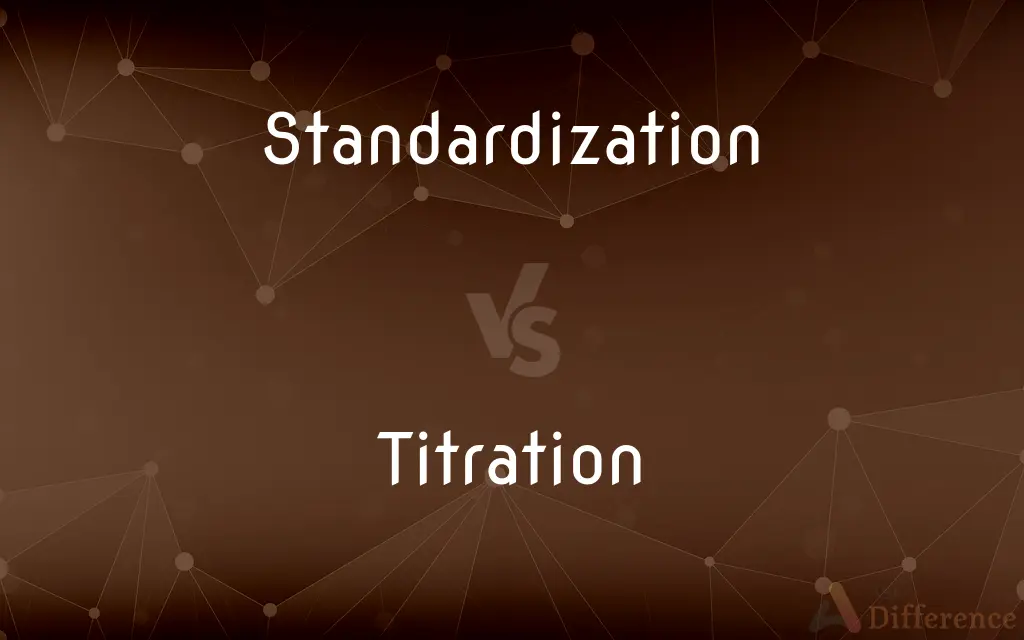Standardization vs. Titration — What's the Difference?
By Tayyaba Rehman & Fiza Rafique — Updated on April 17, 2024
Standardization is the process of confirming the concentration of a solution, whereas titration involves gradually adding one solution to another until a reaction endpoint is reached.

Difference Between Standardization and Titration
Table of Contents
ADVERTISEMENT
Key Differences
Standardization is a critical laboratory procedure used to determine the precise concentration of a solution, often involving the use of a primary standard. On the other hand, titration is a method where one solution (the titrant) is added to another solution until a chemical reaction reaches its endpoint, indicated by a color change or an electrical measurement.
Standardization is typically performed to ensure the accuracy of the solution used in titration, which is crucial for quantitative analysis. Whereas, titration is used to determine the unknown concentration of an analyte in a solution by measuring how much titrant is required to complete the reaction.
In standardization, a high degree of accuracy and precision is necessary, as it directly affects the outcomes of subsequent measurements and experiments. In contrast, the precision in titration depends significantly on the endpoint detection technique used, such as a pH indicator or a potentiometer.
Standardization often uses known weights of a primary standard which reacts with the solution to confirm its concentration. On the other hand, titration typically involves the gradual addition of a titrant to a known volume of the analyte until the endpoint is achieved. Finally, standardization is essential for validating the concentration of solutions used in various titrations, ensuring the results of titration are accurate and reliable.
Comparison Chart
Purpose
To accurately determine the concentration of a solution.
To determine the unknown concentration of an analyte.
ADVERTISEMENT
Method
Uses primary standards to validate solution concentration.
Involves adding one solution to another until reaction completion.
Precision
Requires high precision for accurate concentration verification.
Precision depends on endpoint detection method.
Common Indicators
Not typically used.
PH indicators, color change, or electrical measurements.
Result
Confirms or adjusts the concentration of a solution.
Provides the amount of substance in a given volume.
Compare with Definitions
Standardization
The process of determining the exact concentration of a solution using a primary standard.
The chemist performed standardization to verify the molarity of the hydrochloric acid.
Titration
Involves the gradual addition of a titrant to a solution until the endpoint is reached.
During titration, she added the base slowly until the color change persisted.
Standardization
Focuses on precision and accuracy.
Standardization requires precise measurement of volume and weight for accurate results.
Titration
Uses indicators to signal the completion of the reaction.
The endpoint in his titration was indicated by a sudden color change from pink to clear.
Standardization
A laboratory technique in chemistry.
He learned the importance of standardization during his laboratory training.
Titration
Can be performed using different methods like acid-base, redox, or complexometric titrations.
She performed a redox titration to analyze the iron content.
Standardization
Essential for achieving accurate results in quantitative chemical analysis.
Accurate standardization of solutions ensured reliable results in her experiments.
Titration
A technique in analytical chemistry used to determine the concentration of an analyte.
He used titration to find the concentration of vinegar in the sample.
Standardization
Usually a precursor to quantitative assays like titration.
Before titration, the sodium hydroxide solution was standardized using potassium hydrogen phthalate.
Titration
A common method for quantitative chemical analysis.
Titration is a staple method in chemical laboratories for quantifying unknown substances.
Standardization
Standardization or standardisation is the process of implementing and developing technical standards based on the consensus of different parties that include firms, users, interest groups, standards organizations and governments. Standardization can help maximize compatibility, interoperability, safety, repeatability, or quality.
Titration
Titration (also known as titrimetry and volumetric analysis) is a common laboratory method of quantitative chemical analysis to determine the concentration of an identified analyte (a substance to be analyzed). A reagent, termed the titrant or titrator, is prepared as a standard solution of known concentration and volume.
Standardization
To cause to conform to a standard.
Titration
The process, operation, or method of determining the concentration of a substance in solution by adding to it a standard reagent of known concentration in carefully measured amounts until a reaction of definite and known proportion is completed, usually as shown by a color change or by electrical measurement, and then calculating the unknown concentration.
Standardization
To evaluate by comparing with a standard.
Titration
(analytical chemistry) The determination of the concentration of some substance in a solution by slowly adding measured amounts of some other substance (normally using a burette) until a reaction is shown to be complete, for instance by the colour change of an indicator.
Standardization
The process of complying (or evaluate by comparing) with a standard.
Titration
The act or process of titrating; a substance obtained by titrating.
Standardization
The process of establishing a standard.
Titration
A measured amount of a solution of unknown concentration is added to a known volume of a second solution until the reaction between them is just complete; the concentration of the unknown solution (the titer) can them be calculated
Standardization
The condition in which a standard has been successfully established;
Standardization of nuts and bolts had saved industry millions of dollars
Standardization
The imposition of standards or regulations;
A committee was appointed to recommend terminological standardization
Standardization
The act of checking or adjusting (by comparison with a standard) the accuracy of a measuring instrument;
The thermometer needed calibration
Common Curiosities
What is the main difference between standardization and titration?
Standardization determines the exact concentration of a solution, while titration measures the concentration of an unknown analyte using the standardized solution.
Why is standardization important before titration?
Standardization ensures that the concentration of the titrant is known accurately, which is crucial for obtaining precise results in titration.
Can titration be done without standardization?
While possible, titration without prior standardization can lead to inaccurate results, as the exact strength of the titrant might not be known.
What types of titration are there?
Common types include acid-base, redox, complexometric, and precipitation titrations.
What safety precautions are necessary during titration?
Wearing appropriate safety gear like gloves and goggles, handling chemicals with care, and following proper waste disposal protocols are essential.
Can titration be automated?
Yes, automated titration systems are available and are used to increase precision and efficiency in laboratories.
What role does temperature play in titration and standardization?
Temperature can affect the reaction rate and equilibrium constants, influencing the accuracy of both titration and standardization.
How is the choice of indicator determined for a titration?
The choice of indicator depends on the type of titration and the expected pH or potential change at the endpoint.
What are primary standards in standardization?
Primary standards are pure chemicals with exact known concentrations used to calibrate or verify the concentration of solutions in standardization.
How do you know when titration is complete?
The completion is usually indicated by a color change if an indicator is used or by achieving the desired electrical measurement in potentiometric methods.
Is there a specific type of titration that does not use indicators?
Yes, potentiometric titration does not rely on indicators but uses a potentiometer to detect the endpoint based on changes in electrical potential.
How does the accuracy of the endpoint affect titration results?
The accuracy of detecting the endpoint directly influences the precision of the titration results; inaccurate endpoint detection can lead to significant errors.
What is the most challenging aspect of performing standardization and titration?
Achieving high precision and accuracy, especially in detecting the endpoint in titration and measuring exact concentrations in standardization, is often challenging.
How often should solutions be standardized for accurate titration?
Solutions should be standardized regularly, especially if they are susceptible to changes in concentration over time due to factors like evaporation or decomposition.
Are there digital tools to help with titration?
Digital burettes and software can help in precise control of titrant addition and real-time monitoring of titration curves.
Share Your Discovery

Previous Comparison
Britches vs. Pants
Next Comparison
Ineffable vs. UnspeakableAuthor Spotlight
Written by
Tayyaba RehmanTayyaba Rehman is a distinguished writer, currently serving as a primary contributor to askdifference.com. As a researcher in semantics and etymology, Tayyaba's passion for the complexity of languages and their distinctions has found a perfect home on the platform. Tayyaba delves into the intricacies of language, distinguishing between commonly confused words and phrases, thereby providing clarity for readers worldwide.
Co-written by
Fiza RafiqueFiza Rafique is a skilled content writer at AskDifference.com, where she meticulously refines and enhances written pieces. Drawing from her vast editorial expertise, Fiza ensures clarity, accuracy, and precision in every article. Passionate about language, she continually seeks to elevate the quality of content for readers worldwide.















































